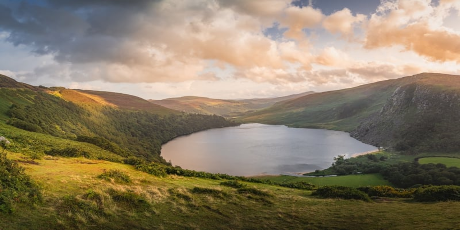Why we need to stop talking about the beauty of nature 26 Jul 2023

Opinion: We need to recognise the job the environment does for us and see ourselves as an essential cog to keep that work going - Dr Emma Verling is a Research Fellow at the MaREI Centre for Energy, Climate and Marine/ERI at UCC
Human societies are entirely dependent on our planet, but environmental and climate crises threaten our future and many of us recognise that something needs to change. Those seeking to inspire us to make that change have turned to the beauty of nature to highlight the importance of protecting and valuing our planet. Yet the various human-generated crises rage on unabated. To make a real difference, we need to set beauty aside and see ourselves not as observers of our environment, but as an inherent part of it.
William Wordsworth, Emily Dickinson and thousands of others have long mused upon the beauty of nature, and today we focus on it more than ever. Breath-taking nature programming, once consigned to a teatime slot is now a staple of global streaming platforms. The advent of social media and improved technology have meant images of nature are never in short supply.
Even our home designs have changed to take in nature. Contrast traditional cottages crouching on Ireland's wind-swept coasts, their blank gable ends turned firmly against the ocean, with today’s newest homes. For the right price, there is no window too big, no view too vast.
But despite the value of a picture window or the appeal of a well-taken photograph, we appear still to be locked in a war with nature through our actions in our own spaces. We mow our lawns to resemble deep pile carpets. We clip our hedges to make them neat. We spray chemicals on native 'weeds’ only to replace them with exotic shrubs from the other side of the world. We drain wetlands and fell trees that don’t fit with our perception of beauty.
We leave no room for the intricacies of natural systems in our crusade to make nature bend to our will. We don't recognise that nature is doing many jobs for us - and it doing them for free. Floodplains protect land beyond them. Natural grasslands, wetlands and flourishing hedges absorb carbon and support species that pollinate our food.
We need to call a truce in this battle of form over function. Like all truces, it will require us to get around a table and talk, and many have already pulled up a chair. In recent years, branches of environmental and social science dedicated to valuing our environment have grown. Examples include the study of Ecosystem Services and Nature Based Solutions and new projects focus on promoting Ecosystem Based Management, Citizen Engagement and Nature Restoration.
Environmental policy-making in Europe and beyond has also changed in the past 20 years, taking a whole ecosystem approach (the EU Marine Strategy Framework Directive), to support earlier policies which dealt with industries one by one, or cherry-picked species and habitats for protection. Communities have become increasingly engaged with environmental and climate issues, bringing with them vital local knowledge and a deep commitment to their own areas.
While these advances have meant there is now a growing understanding of the environment's vital role in our future, barriers remain which make some of us reluctant to take a seat at the table. The biodiversity and climate crises can often scare people, with media reports painting a problem too big for most to fathom, let alone solve.
Scientific writing about the environment can shut people out. It appears academic and patronising, preaching to those who feel they know their area better than anyone. Industries appear focused on profit margins or are accused of not communicating their plans sufficiently and policy-making can be regarded as mere box-ticking. A natural fear of change within communities may cause new approaches to be rejected at an early stage. Overall, it has been hard to find a common ground.
We need an immense attitude shift to secure our futures and those of generations to come. There has to be a conscious effort from all sides - from communities, scientists, policy-makers, media outlets and industries. To achieve this, we must firstly actively engage with each other, listening and working together with openness. Secondly, we all need to examine how we relate to the environment and the way that we treat it.
This cannot be done by just gazing admiringly at it from the outside or by moulding it into something we regard as beautiful. Instead, we need to recognise the job the environment does for us and see ourselves as an essential cog to keep that work going.
Children and young people think our relationship with the earth should resemble one with a friend or family member. They can see that nature is neither an unruly enemy nor a beautiful stranger on our arm, but an ally to whom we must give and take for the good of us both. Perhaps we should think of it as a long, successful marriage? As those who have achieved such a thing will tell you, looks don’t really come into it.